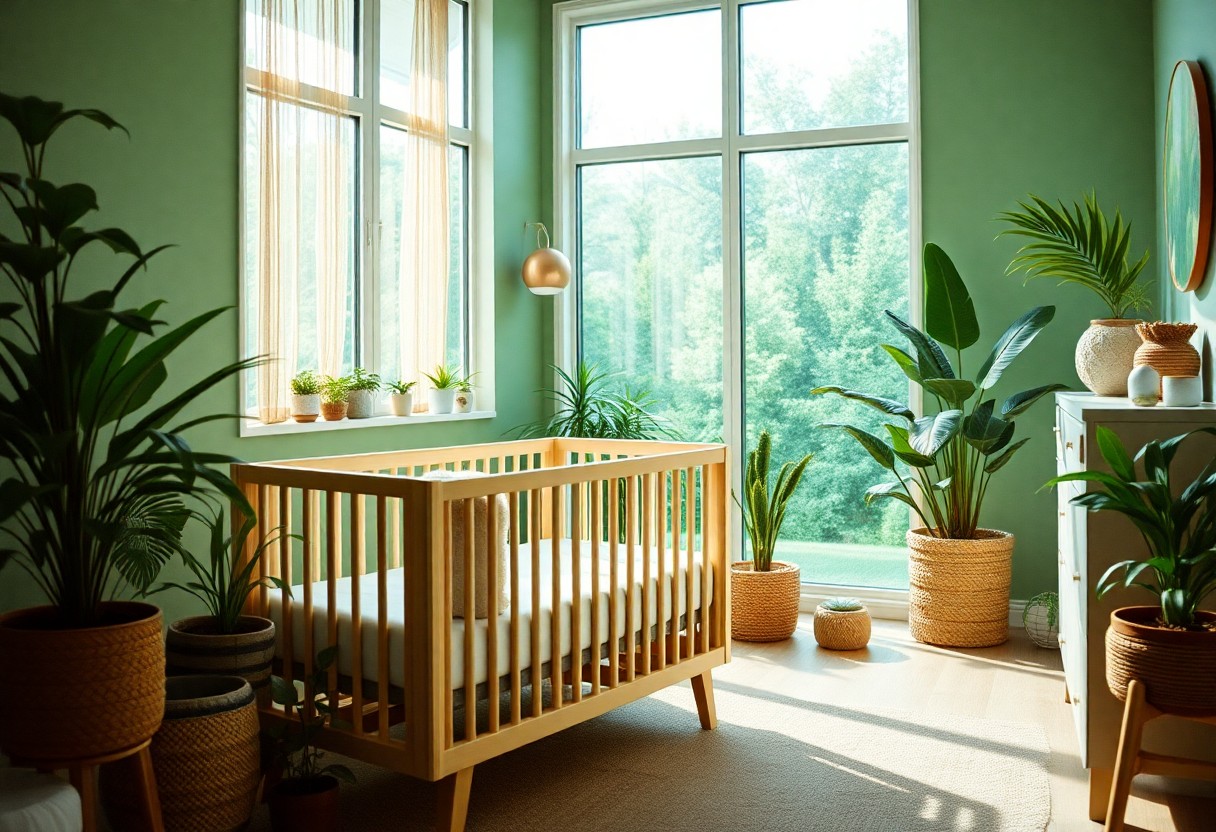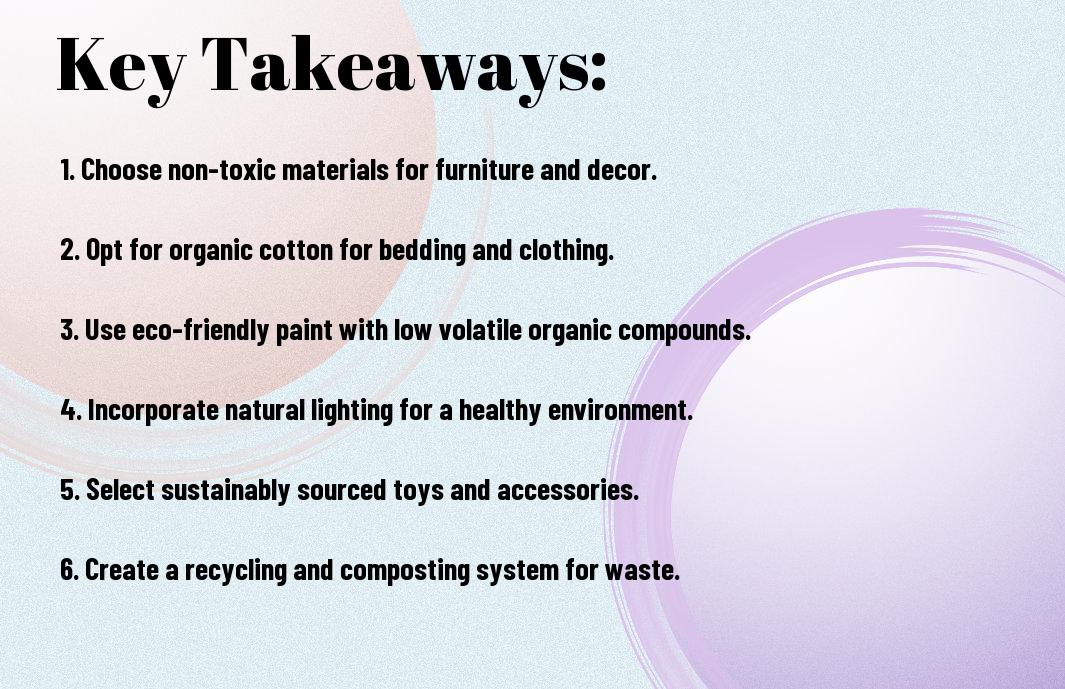As you prepare to welcome your little one, you’re likely thinking about creating a safe and healthy space for your baby to grow. You want your nursery to be a haven, not only for your child, but also for the planet. By making eco-friendly choices, you can design a beautiful and sustainable nursery that promotes your baby’s well-being and supports a greener future. In this post, you’ll learn how to make conscious decisions to build a green nursery that nurtures your baby and the environment.

Key Takeaways:
To create a healthy and sustainable environment for your baby, consider the following points when building a green nursery:
- Choose non-toxic and eco-friendly materials for the walls, floor, and furniture to minimize exposure to harmful chemicals and promote a healthy environment.
- Opt for energy-efficient lighting and renewable energy sources, such as solar power, to reduce your carbon footprint and create a more sustainable space.
- Incorporate natural elements, such as plants and organic textiles, to bring a sense of calm and wellness into the nursery, and to help purify the air and improve indoor air quality.

Planning Your Green Nursery
Your journey to creating a green nursery begins with a thoughtful planning process, considering your lifestyle, budget, and the well-being of your baby and the planet.
Assessing Your Space
Besides considering the size and layout of the room, take note of the natural light, ventilation, and any potential environmental hazards, such as lead paint or mold, to ensure a safe and healthy space for your baby.
Setting Eco-Friendly Goals
Only by defining your eco-friendly objectives can you make informed decisions about the materials, products, and practices that will go into creating your green nursery, allowing you to prioritize your values and make a positive impact on the environment.
To achieve your eco-friendly goals, you will need to consider factors such as sustainability, energy efficiency, and non-toxic materials, and make choices that align with your vision for a healthy and environmentally conscious nursery, allowing you to create a peaceful and nurturing space for your baby to grow and thrive.
Choosing Sustainable Materials
While designing your baby’s nursery, you’ll want to select materials that are gentle on the planet and promote a healthy environment for your little one to grow. Consider using reclaimed wood, bamboo, and low-VOC (volatile organic compound) materials to create a nurturing space.
Eco-Friendly Paints and Finishes
Following your decision on the overall aesthetic, you’ll find that eco-friendly paints and finishes can add a beautiful touch to your nursery. You can choose from a variety of natural paints, such as those made from plant dyes or mineral pigments, to ensure a safe and healthy space for your baby.
Sustainable Furniture Options
Along with the walls and floors, you’ll want to think about the furniture that will fill your nursery. You can opt for sustainably sourced wood, repurposed or recycled materials, or even second-hand furniture to reduce waste and minimize your environmental footprint.
But as you explore sustainable furniture options, you’ll discover that it’s not just about the materials used, but also about the longevity and versatility of the pieces. You can invest in a crib that converts to a toddler bed, or a changing table that becomes a dresser, allowing you to adapt your nursery as your baby grows, and reducing the need for new purchases and potential waste.
Selecting Non-Toxic Products
To create a healthy environment for your baby, you’ll want to choose products that are free from harmful chemicals and toxins. You can start by selecting items made from natural materials, such as wood and cotton, and opting for products with non-toxic certifications.
Safe Bedding and Mattresses
Safely choosing bedding and mattresses is imperative for your baby’s health. You can look for products made from organic materials, such as cotton and wool, and avoid those with chemical treatments.
Chemical-Free Toys and Decor
Beneath the surface of many toys and decorations, harmful chemicals can lurk. You can find alternatives made from natural materials, such as wood and fabric, and choose items with non-toxic finishes.
Hence, as you explore the world of chemical-free toys and decor, you’ll discover a wide range of options that are both safe and sustainable. You can consider handmade items, second-hand toys, and eco-friendly brands that prioritize your baby’s health and the environment. By making these choices, you’ll be creating a nurturing space for your baby to grow and thrive.
Creating a Healthy Indoor Environment
Unlike other rooms in your home, a nursery requires special attention to create a healthy space for your baby. You can achieve this by considering factors such as air quality, temperature, and humidity.
Improving Air Quality
Among the most effective ways to purify the air is by using natural methods, such as opening windows and using plants that absorb toxins, allowing you to create a fresh and clean environment for your baby.
Maintaining a Comfortable Temperature
Below are some guidelines to help you maintain a comfortable temperature in your baby’s nursery, outlined in the following
| Season | Temperature Range |
|---|---|
| Winter | 68-72°F (20-22°C) |
| Summer | 71-75°F (22-24°C) |
Indoor temperature control is vital for your baby’s comfort and health. You can maintain a comfortable temperature by using eco-friendly heating and cooling systems, and ensuring proper insulation in your home. Consider the following
| Option | Eco-Friendliness |
|---|---|
| Solar Heating | Highly Eco-Friendly |
| Geothermal Cooling | Highly Eco-Friendly |
Decorating with Nature in Mind
After considering the overall aesthetic you want to achieve in your nursery, think about how you can incorporate natural elements into the design. This can include using reclaimed wood, natural fiber rugs, and earthy tones to create a calming and organic atmosphere.
Using Natural Textiles and Fabrics
One of the easiest ways to bring a touch of nature into your nursery is by choosing natural textiles and fabrics, such as organic cotton, bamboo, or hemp, for your baby’s bedding, curtains, and clothing.
Incorporating Plants and Greenery
Between the countless benefits of having plants in your nursery, from air purification to stress reduction, you’ll find that adding some greenery to the space is a simple yet effective way to create a healthier environment for your baby.
Indeed, as you consider the types of plants to incorporate into your nursery, you’ll want to opt for low-maintenance, non-toxic varieties that are safe for your baby to be around, such as spider plants or snake plants, and place them in areas where they can thrive, like a sunny windowsill or a hanging basket, allowing you to enjoy the benefits of nature while creating a peaceful ambiance for your little one.
Implementing Energy-Efficient Solutions
Many parents strive to create a sustainable environment for their baby. You can start by learning about Creating an Eco-friendly Nursery for your Baby to make informed decisions.
Energy-Saving Lighting Options
Around your nursery, you can install LED bulbs, which consume less energy and last longer, making them a great choice for your baby’s space.
Reducing Energy Consumption
Reducing your energy usage is easier than you think, starting with simple habits like turning off lights and electronics when not in use, which will help you create a more sustainable nursery.
But as you explore ways to minimize your energy consumption, you’ll find that making a few thoughtful changes can have a significant impact on the environment and your baby’s well-being, so take your time to assess your nursery’s energy efficiency and make adjustments accordingly, considering factors like insulation, windows, and appliance efficiency to ensure your baby’s space is not only beautiful but also eco-friendly.
Summing up
Ultimately, you have the power to create a nurturing and eco-friendly space for your baby. By choosing sustainable materials, minimizing waste, and incorporating natural elements, you can build a green nursery that promotes a healthy environment for your little one to grow. As you make these thoughtful decisions, you’re not only designing a beautiful space, but also teaching your child the value of living in harmony with nature, and that’s a gift that will last a lifetime, shaping your baby’s future in a positive way, and yours too, as a parent.
FAQ
Q: What are the benefits of building a green nursery for my baby?
A: Building a green nursery for your baby provides a healthy and sustainable environment that promotes well-being and development. A green nursery reduces exposure to toxic chemicals, improves indoor air quality, and creates a peaceful atmosphere. This eco-friendly space also teaches your baby about the importance of living in harmony with nature from an early age.
Q: How do I choose eco-friendly materials for my nursery?
A: When dicking out materials for your nursery, opt for sustainable and non-toxic options such as bamboo, reclaimed wood, and low-VOC (volatile organic compound) paints. Consider the source and production process of the materials to ensure they are environmentally friendly. You can also look for certifications like Greenguard Gold or Oeko-Tex, which guarantee that the products meet rigorous standards for health and sustainability.
Q: What are some tips for reducing waste and clutter in the nursery?
A: To reduce waste and clutter in the nursery, consider buying second-hand furniture and decor, and choose items with minimal packaging. Opt for multi-functional furniture that serves more than one purpose, and avoid single-use items. You can also implement a “one in, one out” policy to prevent clutter from building up. Additionally, consider using a diapering system that is reusable and eco-friendly, such as cloth diapers or a diaper service.
Q: How can I improve the air quality in my baby’s nursery?
A: Improving air quality in the nursery is necessary for your baby’s health. You can start by ensuring good ventilation, using an air purifier, and maintaining a consistent cleaning schedule. Choose cleaning products that are free from harsh chemicals and opt for necessary oil-based diffusers instead of synthetic fragrances. You can also add some air-purifying plants like spider plants or peace lilies to the nursery to help remove toxins from the air.
Q: What are some eco-friendly decorating ideas for the nursery?
A: There are many eco-friendly decorating ideas for the nursery that are both stylish and sustainable. Consider using natural textiles like organic cotton, hemp, or bamboo for bedding and curtains. You can also create a beautiful and unique mobile using recycled materials like cardboard, fabric scraps, or natural fibers. Add some warmth and personality to the space with eco-friendly wall art, such as prints or paintings made from natural materials. Finally, incorporate some plants or a living wall to bring in a touch of nature and freshness to the nursery.

